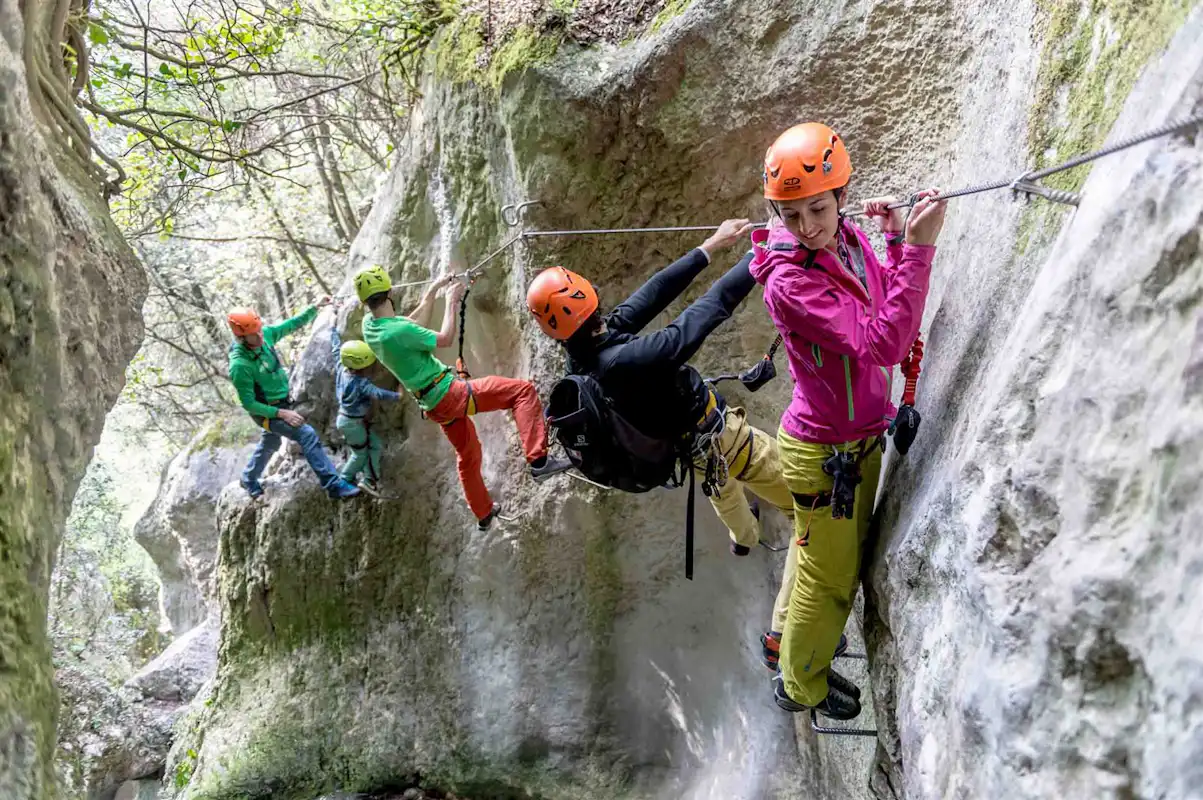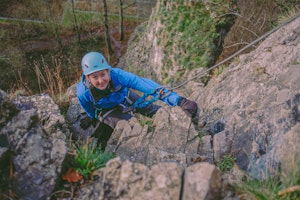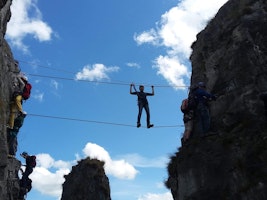A via ferrata ―an Italian term which means ‘iron path’― is a protected climbing route, built with a steel cable rail fixed to the rock, metal steps, ladders, suspension bridges and zip wires.
The word defines both the route and the outdoor activity, which consists on progressing through the via ferrata by using a harness clipped onto the wire. Half-way between scrambling and rock climbing, via ferratas allow non-expert climbers to reach high altitudes in a safe way, using minimum equipment.
The origins of via ferratas can be traced back to World War I. In order to allow the troops to make their way through the mountains, many protected routes were built in the Dolomites, a mountain range in northeastern Italy, very close to the border with Austria. Many of those routes have been restored by the Italian Alpine Club and became accessible to travelers, giving birth to via ferratas as an outdoor activity on its own right.
In the last 20 years, via ferratas have grown into a popular sport and many routes were built in different countries, especially in the Alpine region. In Austria and Germany, via ferratas are known as Klettersteig.
Via ferratas are a great way of exploring the mountains. This sport does not necessarily requires previous mountain experience, but you will need to have a good physical condition and no fear of heights. Some routes are accessible for children aged 8 and up, making it an exciting option for a family active holiday.
Routes are classified in different levels of difficulty, depending on its length, exposure and the level of strength required. They can take between one to more than eight hours to complete. For the most adventurous, it's also possible to link several via ferratas or book a guide for a multi-day experience.
Sometimes, via ferratas provide escape routes on the way up, just in case you need to return before the ending point. However, most of them imply a commitment to finish the whole route, as you can only move forward.
When is the best time of the year to practice it?

A via ferrata trip requires good weather conditions and that means avoiding rain, snow and ice. Summer, spring and even autumn months are the best time to practice this activity. During winter, snow and ice can make the routes unstable, slippery and dangerous, especially in higher peaks.
What equipment do you need?

These are the basic items of a via ferrata equipment:
A climbing harness
Via ferrata set, consisting of two carabiners and a lanyard to attach the harness to the steel cable.
Helmet: this is a must! Potential rockfall is one of the main risks in via ferratas, so protecting your head is mandatory.
Gloves: to protect your hands from friction with the rock and the steel cable, and also to provide a better grip.
Climbing rope and belay device: these are not essential but may be useful for extra security for the most difficult routes or to protect children.
When hiring a mountain guide, the via ferrata equipment is usually provided within the price. In other occasions, it can be rented at an extra cost.
Why hire a guide for a via ferrata trip?

Via ferratas may seem an easy undertaking but they involve risks just as any other mountain activity. A certified mountain guide will watch out for your safety, teach you the basic via ferrata techniques and show you how to use the equipment properly. Hiring a guide is especially recommended if it’s your first via ferrata trip or if you are taking children. Besides, a guide can provide an invaluable knowledge of the area, either in terms of logistics or when it comes to interesting facts.
10 best spots in the world to practice via ferrata

1| The Dolomites, in Italy, are the place where via ferrata were born. Pick a route from our guide to the best via ferrata spots and get ready to enjoy these magnificent limestone peaks!
2| Slovenia is an outdoor mecca, with many exciting via ferrata routes to tackle. Head to Bled or Mojstrana for an adventure in the Julian Alps.
3| Germany: you’d better call them Klettersteig here! The most adventurous can reach the summit of Zugspitze ―the highest peak in the country― by climbing a very demanding via ferrata.
4| Barcelona: on the coast of the Mediterranean Sea, this amazing Spanish town provides different routes for all levels. Check out our guide for the best via ferratas in the area!
5| Belgium: this Western Europe country boasts many via ferrata routes for an exhilarating mountain adventure!
6| Haute Savoie (France): hit this beautiful department in the French Alps for some via ferrata action! Search different options in Chamonix-Mont-Blanc and Annecy.
7| Austria: this may be the country with the largest number of via ferrata routes (there are over 500!). If you’ve been hooked on this sport, you’d better add it to your bucket list.
8| Czech Republic: make your pick from the several routes available and get ready for a sporty journey in the Giant Mountains!
9| Aosta Valley: it’s not all about the Dolomites in Italy! The Aosta Valley has been developed different via ferrata routes recently and offers many interesting options.
10| Andalusia: in the south of Spain, via ferratas are an excellent choice for an active holiday exploring the beautiful Sierra Nevada!








